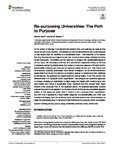Re-purposing Universities: The Path to Purpose
| dc.contributor.author | Hurth, V | |
| dc.contributor.author | Stewart, Iain | |
| dc.date.accessioned | 2022-02-08T12:35:50Z | |
| dc.date.available | 2022-02-08T12:35:50Z | |
| dc.date.issued | 2021-01-01 | |
| dc.identifier.issn | 2673-4524 | |
| dc.identifier.issn | 2673-4524 | |
| dc.identifier.uri | http://hdl.handle.net/10026.1/18681 | |
| dc.description.abstract |
<jats:p>As the extent of damage to environmental systems from our business-as-usual activity becomes ever more alarming, Universities as core social institutions are under pressure to help society lead the transition to a sustainable future. Their response to the issues, that they themselves have helped reveal, has, however, been widely criticised for being wholly inadequate. Universities can be observed to engage with sustainability issues in<jats:italic>ad-hoc</jats:italic>ways, with the scale of attention and commitment dependant mainly on the level of pressure exerted by stakeholders that works to overcome aspects of inherent inertia. Sustainability initiatives can therefore be regarded mainly as bolt-ons. This mirrors how other sectors, including businesses, have tended to respond. As the environmental and social crisis mounts and the window for adaptive change to ensure long-term wellbeing for all narrows, the pressure for deeper systemic change builds. It is in this context that transformation to a “purpose-driven organisation” has emerged as a systemic approach to change, enabling an organisation to align deeply and rapidly with society's long-term best interest and hence a sustainable future. Nowhere has this concept been taken forward more obviously than in the business sector. As business leadership towards purpose becomes more apparent, so the lack of action in this area by universities appears starker. In this paper we clarify what it means to be a purpose-driven organisation, why and how it represents a deep holistic response to unsustainability, and what core questions emerging from the business world university leaders can ask themselves to begin the practical journey to transform their institutions into purpose-driven universities.</jats:p> | |
| dc.format.extent | 762271- | |
| dc.language.iso | en | |
| dc.publisher | Frontiers Media SA | |
| dc.rights | Attribution-ShareAlike 4.0 International | |
| dc.rights | Attribution-ShareAlike 4.0 International | |
| dc.rights | Attribution-ShareAlike 4.0 International | |
| dc.rights | Attribution-ShareAlike 4.0 International | |
| dc.rights.uri | http://creativecommons.org/licenses/by-sa/4.0/ | |
| dc.rights.uri | http://creativecommons.org/licenses/by-sa/4.0/ | |
| dc.rights.uri | http://creativecommons.org/licenses/by-sa/4.0/ | |
| dc.rights.uri | http://creativecommons.org/licenses/by-sa/4.0/ | |
| dc.title | Re-purposing Universities: The Path to Purpose | |
| dc.type | journal-article | |
| dc.type | Journal Article | |
| plymouth.volume | 2 | |
| plymouth.publication-status | Published online | |
| plymouth.journal | Frontiers in Sustainability | |
| dc.identifier.doi | 10.3389/frsus.2021.762271 | |
| plymouth.organisational-group | /Plymouth | |
| plymouth.organisational-group | /Plymouth/Faculty of Science and Engineering | |
| plymouth.organisational-group | /Plymouth/Research Groups | |
| plymouth.organisational-group | /Plymouth/Research Groups/Marine Institute | |
| plymouth.organisational-group | /Plymouth/Users by role | |
| plymouth.organisational-group | /Plymouth/Users by role/Researchers in ResearchFish submission | |
| dc.identifier.eissn | 2673-4524 | |
| dc.rights.embargoperiod | Not known | |
| rioxxterms.versionofrecord | 10.3389/frsus.2021.762271 | |
| rioxxterms.licenseref.uri | http://creativecommons.org/licenses/by-sa/4.0/ | |
| rioxxterms.type | Journal Article/Review |



